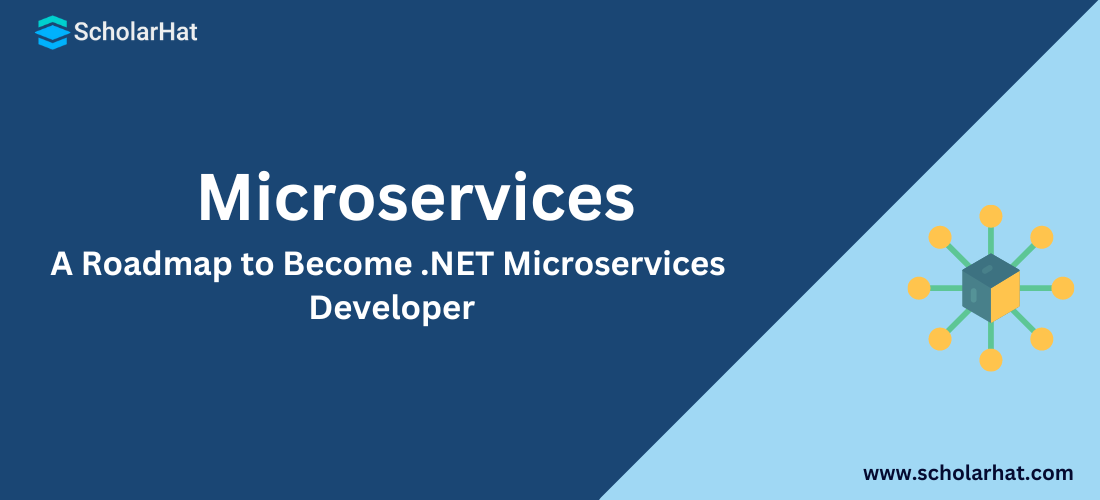10
meiMicroservices Roadmap to Become .NET Microservices Developer
Overview of Microservices Roadmap
To become a.NET Microservices Developer, you must master various technologies and practices inside the.NET ecosystem. The Microservices Roadmap summarises fundamental principles, benefits, limitations, and critical technologies such as .NET Fundamentals, ASP.NET Core, and containerization. Understanding principles like service discovery, communications, and security is essential as is real-world project experience & best practices.
What are microservices?
Microservices, or small units with defined responsibilities, solve specific issues. They build an ecosystem of separate, collaborative services that enable highly automated, ever-changing software. Each microservice launches independently, free of the constraints of technology stacks or frameworks. This architecture promotes scalability and flexibility, allowing for the easy creation and deployment of various services.
Key Principles of Microservices
- Modeled around business domain: Separate system capability into different domains and each domain will focus on one thing and its associated logic.
- Culture of Automation: Follow the culture of automation by designing it for continuous integration and continuous delivery.
- Hide implementation details: Hiding the internal details reduces the coupling and helps to make changes and improvements without affecting the overall architecture.
- Decentralization: There is no centralized database, usually each service is designed to manage its database.
- Deploy Independently: Each service can be deployed independently.
- Failure Isolation: The impact of a failure is less in microservice architecture compared to the monolithic type as it will only affect that particular service and its associates. Other services can keep running.
- Highly Observable: The services should collect as much information to analyze what is happening within each of them like log events and stats.
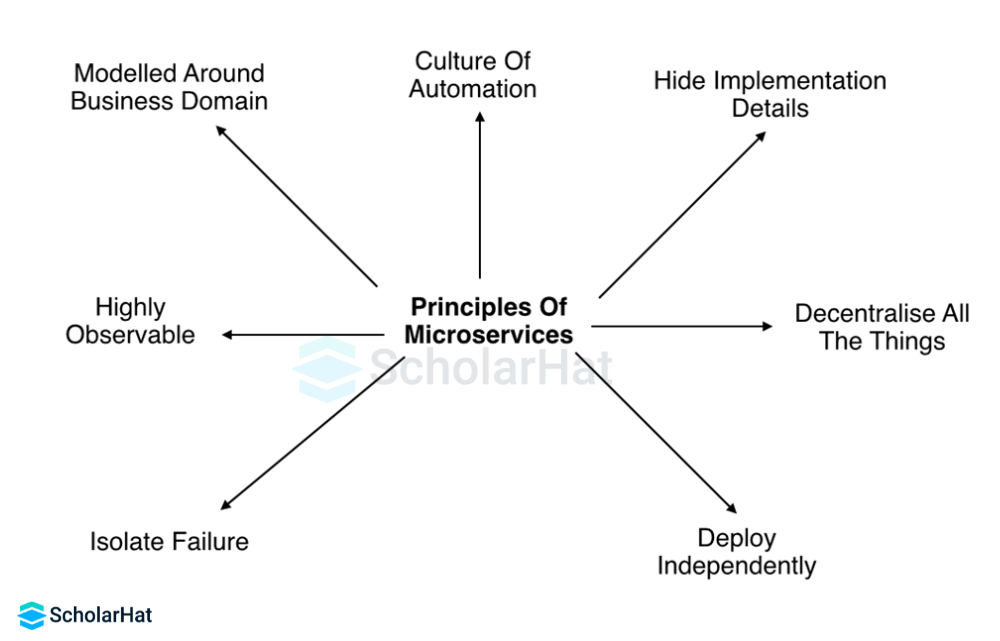
Advantages of Microservices
- Language and Framework Independence: Microservices are based on the notion of being independent of the programming language or framework utilized. This enables developers to select the optimal tools for each given service, increasing flexibility and preventing vendor lock-in.
- Independent development, deployment, and versioning: Each microservice is built, deployed, and versioned independently. This means that modifications to one service do not influence others, allowing for shorter development cycles, easier testing, and smoother deployments.
- Scalability: Individual microservices can be scaled based on their specific requirements, with higher-demand services requiring more resources and lower-demand services requiring fewer resources. This guarantees that resources are used efficiently and that the entire program is not scaled to meet the needs of just one service.
- Fault Isolation: Because of its inbuilt isolation, failures in one microservice do not affect others. This improves overall application resilience and prevents outages from impacting the entire system.
- Zero-downtime upgrades: New versions of microservices can be deployed without disrupting the entire application. This enables ongoing improvement and updates without disrupting users.
- Distributed Architecture: Microservices can be hosted on many servers or even across data centers, allowing for geographical distribution and increased disaster recovery capabilities.
- CI/CD Support: Microservices' independence makes them ideal for continuous integration and delivery (CI/CD) pipelines, which streamline development and deployment procedures.
Challenges of Microservices
- Complexity: A microservices application is more complex as compared to the equivalent monolithic application.
- Development and testing: Building and testing a service that relies on other services needs domain understanding and refactoring them can be difficult.
- Lack of governance: The decentralized approach to building microservices has advantages, but it also leads to so many problems like maintenance because of many different languages and frameworks.
- Network congestion and latency: The use of many small, services can result in additional latency because of interservice communication and a long chain of service dependencies. So design APIs carefully and use asynchronous communication patterns.
- Data Integrity: Each microservice is responsible for its data persistence. As a result, data consistency can be a challenge.
- Management: To be successful with microservices requires a mature DevOps culture. Correlated logging across services can be challenging for a single-user operation.
- Versioning: Be careful while updating a service. It must not break services that depend on it. So without careful design, you might have problems with backward or forward compatibility.
- Skillset: Microservices are highly distributed systems. So need a skilled and experienced team to implement it.
Key Technologies
1. Know .NET Fundamentals
- Understand C# Programming: Ensure you have a strong grasp of C# programming language as it's the primary language used for .NET development.
- Object-Oriented Principles: Familiarize yourself with object-oriented programming (OOP) concepts like inheritance, encapsulation, and polymorphism, which are fundamental in C# and .NET development.
2. Familiarity with .NET Framework and .NET Core
- Understand .NET Ecosystem: Gain knowledge about the .NET ecosystem, which includes both .NET Framework and .NET Core (now .NET 5 and later versions).
- .NET Framework: Familiarize yourself with the traditional .NET Framework, which has been widely used for Windows desktop and web applications.
- .NET Core (now .NET 5+): Understand the evolution of .NET Core into .NET 5 and later versions, which emphasizes cross-platform development and modern features for building microservices.
3. Explore ASP.NET Core
- Understand ASP.NET Core: ASP.NET Core is a cross-platform framework for building web applications and microservices in .NET. Explore its features, architecture, and advantages in comparison to the traditional ASP.NET Framework.
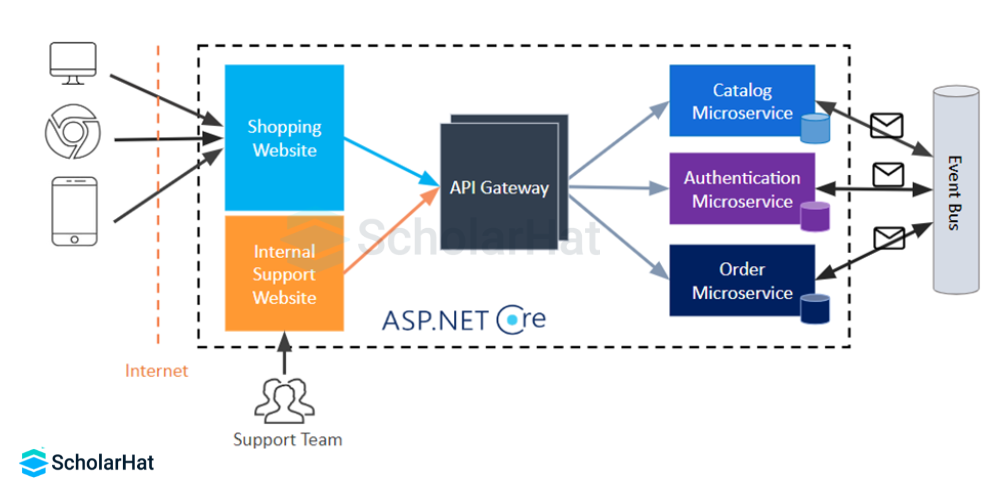
- Cross-Platform Capability: ASP.NET Core allows developers to build applications that can run on Windows, Linux, and macOS, making it suitable for microservices deployments across various platforms.
- Lightweight and Modular: ASP.NET Core is designed to be lightweight and modular, enabling better performance and easier maintenance compared to its predecessor.
4. Familiarize Yourself with Middleware
- Middleware Pipeline: Learn about the concept of middleware in ASP.NET Core, which allows you to handle HTTP requests and responses in a pipeline. Middleware components can perform tasks such as authentication, logging, compression, and more.
- Custom Middleware: Understand how to create custom middleware to add custom behavior to the request processing pipeline according to the requirements of your microservices.
5. Dependency Injection
- Dependency Injection (DI): Familiarize yourself with the built-in dependency injection container provided by ASP.NET Core. DI is essential for managing the dependencies of your microservices, promoting loose coupling, and facilitating easier unit testing.
- Service Registration: Learn how to register services and dependencies in the ASP.NET Core dependency injection container, ensuring that they can be injected into your microservice components where needed.
6. Routing
- URL Routing: Understand how URL routing works in ASP.NET Core, allowing you to define routes for incoming HTTP requests and map them to specific actions or controllers.
- Attribute Routing: Explore attribute routing, a feature of ASP.NET Core that allows you to define routes directly on controller actions or methods using attributes, providing more flexibility in defining routes for your microservices.
7. Creating APIs using ASP.NET Core
- WebAPI: Learn how to create APIs using ASP.NET Core's WebAPI framework. WebAPI allows you to build RESTful APIs that can be consumed by client applications, including other microservices within your architecture.
- Controller Actions: Understand how to define controller classes and actions to handle incoming API requests, and how to serialize/deserialize data using JSON or other formats commonly used in microservices communication.
8. Understanding Microservices Architecture and Principles
- Single Responsibility: Understand the principle of single responsibility, which states that a microservice should have a single responsibility or serve a single business function. Each microservice should be focused on doing one thing well.
- Bounded Context: Familiarize yourself with the concept of bounded contexts in Domain-Driven Design (DDD). Bounded contexts define clear boundaries within which terms and concepts have specific meanings. Each microservice typically corresponds to a bounded context, ensuring a clear separation of concerns.
- Decentralized Data Management: Learn about decentralized data management in a microservices architecture. Rather than having a centralized database, each microservice typically manages its data, often using a database that is best suited to its specific needs (such as SQL or NoSQL).
- Communication Patterns: Explore different communication patterns used in microservices architecture, such as synchronous HTTP-based communication (RESTful APIs), asynchronous messaging (e.g., using message queues like RabbitMQ or Azure Service Bus), or event-driven architectures (e.g., using technologies like Kafka or Azure Event Hubs).
9. Study Containerization Technologies like Docker
- Docker Basics: Familiarize yourself with Docker, a popular containerization platform used for packaging, distributing, and running applications in lightweight, isolated containers.
- Docker Concepts: Understand key Docker concepts such as containers, images, Dockerfile, and Docker Compose. Containers are instances of Docker images, which are lightweight, standalone, executable packages that include everything needed to run a piece of software.
- Docker CLI: Learn how to use the Docker command-line interface (CLI) to interact with Docker, including commands for building, managing, and running containers.
10. Packaging Microservices and Dependencies
- Containerizing Microservices: Understand how to package .NET microservices into Docker containers. Each microservice can be packaged as a separate container with its dependencies, libraries, and runtime environment.
- Dependency Isolation: Containers provide dependency isolation, ensuring that each microservice runs in its isolated environment with the specific dependencies it requires. This helps to avoid conflicts and compatibility issues between microservices.
11. Consistent Environment across Development, Testing, and Production
- Development Workflow: Learn how containerization enables a consistent development workflow across different environments. Developers can build and test microservices locally in Docker containers, ensuring that they run in the same environment as they do in production.
- Testing and CI/CD: Integrate Docker containers into your testing and continuous integration/continuous deployment (CI/CD) pipelines. Containerized microservices can be easily deployed and tested in automated testing environments, streamlining the testing and deployment process.
- Production Deployment: Deploy containerized microservices to production environments using container orchestration platforms like Kubernetes or Docker Swarm. Container orchestration simplifies the management and scaling of microservices in production, providing features such as automated scaling, rolling updates, and service discovery.
12. Explore the Concept of API Gateway
- Reverse Proxy: Understand that an API Gateway acts as a reverse proxy for microservices. It sits between clients and backend microservices, routing incoming requests to the appropriate microservice based on defined rules.
- Centralized Concerns: Recognize that an API Gateway provides centralized management of cross-cutting concerns such as authentication, authorization, load balancing, caching, and logging. This helps to simplify the implementation of these concerns across multiple microservices.
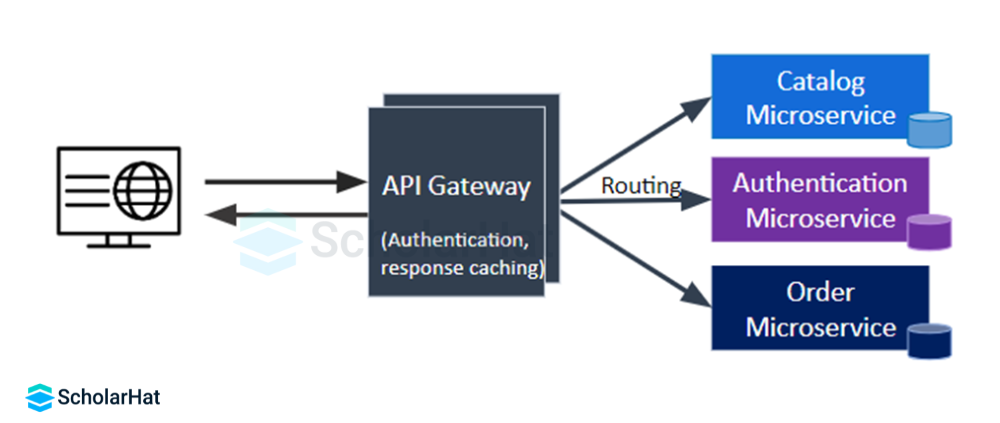
13. Learn Ocelot, SteelToe, or Azure APIM
- Ocelot: Study Ocelot, an open-source API Gateway built specifically for .NET applications. Ocelot is highly configurable and provides features such as routing, authentication, authorization, load balancing, and request/response transformations.
- SteelToe: Explore SteelToe, a .NET library that provides tools for building cloud-native applications, including integration with APIs and microservices. SteelToe includes components for service discovery, circuit breakers, and distributed tracing.
- Azure APIM (API Management): Familiarize yourself with Azure API Management, a fully managed service offered by Microsoft Azure for building, deploying, and managing APIs. Azure APIM provides features such as API gateway functionality, developer portal, analytics, and security policies.
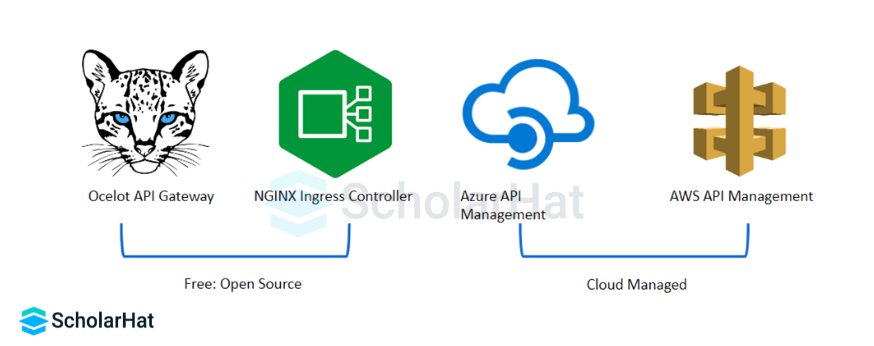
14. Integration with Backend Microservices
- Routing and Load Balancing: Learn how to configure the API Gateway to route incoming requests to the appropriate backend microservices based on defined routes and rules. The API Gateway can also perform load balancing to distribute traffic evenly across multiple microservices instances.
- Authentication and Authorization: Understand how to implement authentication and authorization mechanisms in the API Gateway to secure access to backend microservices. This may involve integrating with identity providers such as Azure Active Directory or implementing custom authentication schemes.
- Caching: Explore how the API Gateway can cache responses from backend microservices to improve performance and reduce latency. Cached responses can be served to clients without hitting the backend microservices, reducing the load on the system.
15. Understand Service Discovery Mechanisms
- Dynamic Service Location: Recognize that in a microservices environment, services need to locate and communicate with each other dynamically as instances of services may come and go due to scaling, deployment, or failure.
- Service Registry: Understand the concept of a service registry, a central repository where information about available services and their locations is stored. Service instances register themselves with the registry, and other services can query the registry to discover available instances.
- Health Checking: Learn about health-checking mechanisms used in service discovery to ensure that only healthy instances are listed in the service registry. Health checks periodically monitor the status of service instances and update the registry accordingly.
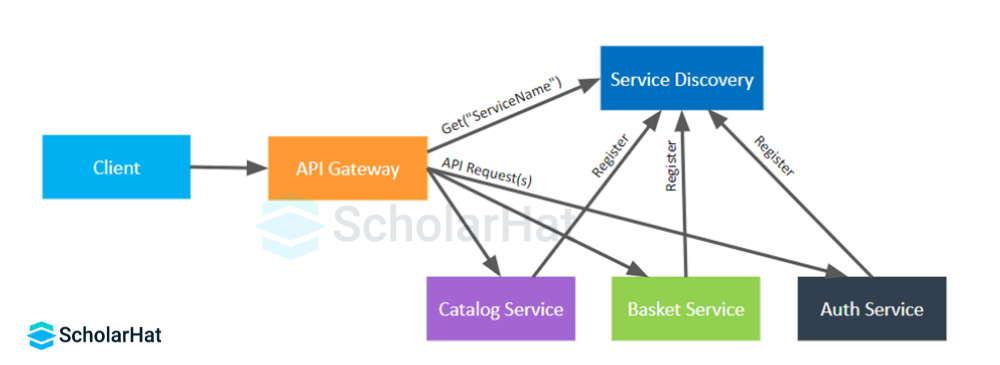
16. Learn Service Discovery Tools
- Consul: Study Consul, a distributed service mesh solution provided by HashiCorp. Consul includes features for service discovery, service mesh networking, health checking, and key-value storage. It can be used as a service registry in microservices architectures.
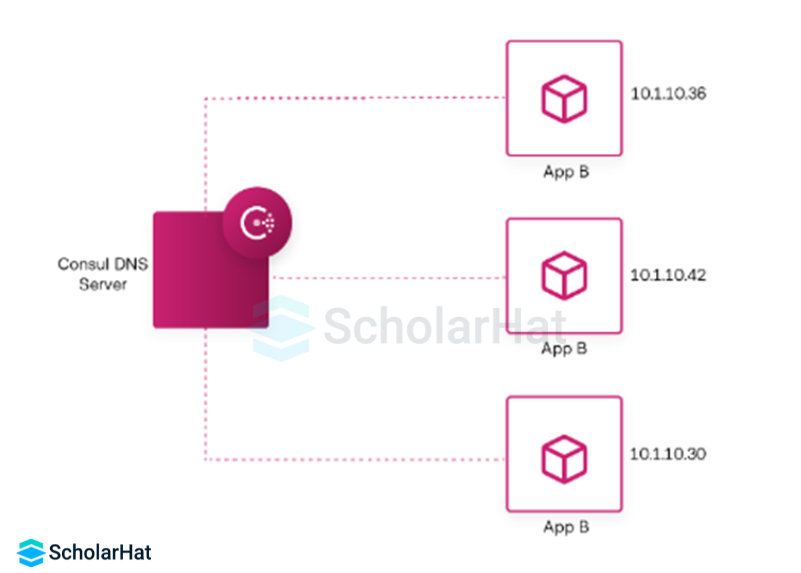
- Eureka: Explore Eureka, a service discovery tool developed by Netflix and open-sourced as part of the Netflix OSS suite. Eureka provides a RESTful interface for service registration and discovery and is commonly used in combination with Spring Cloud for Java microservices.
- Kubernetes Service Discovery: Understand how service discovery works in Kubernetes, a popular container orchestration platform. Kubernetes includes built-in service discovery mechanisms that allow services to discover and communicate with each other using DNS-based service names.
17. Integration with .NET Microservices
- Client-Side Discovery: Learn how to implement client-side service discovery in .NET microservices using libraries or frameworks that support dynamic service resolution. In this approach, client services query the service registry directly to discover available service instances.
- Server-Side Discovery: Understand how to implement server-side service discovery in .NET microservices by integrating with service discovery tools like Consul or Eureka. In this approach, service instances register themselves with the service registry, and client requests are routed through a load balancer or gateway that consults the registry to locate the target service instance.
18. Delve into Event-Driven Architecture (EDA)
- Asynchronous Communication: Event-driven architecture (EDA) emphasizes asynchronous communication between microservices through the exchange of events. Events represent significant occurrences within the system and can trigger actions or state changes in other microservices.
- Loose Coupling: EDA promotes loose coupling between microservices by allowing them to interact indirectly through events. Microservices only need to know about the events they produce or consume, rather than having direct dependencies on each other's implementations.
- Scalability and Resilience: EDA facilitates scalability and resilience by decoupling the processing of events from the generation of events. Microservices can handle events independently and at their own pace, enabling better resource utilization and fault isolation.
19. Learn Message Brokers
- Azure Service Bus: Explore Azure Service Bus, a fully managed messaging service provided by Microsoft Azure. Azure Service Bus supports both queues and topics for point-to-point and publish-subscribe messaging patterns, making it suitable for building event-driven architectures in the cloud.
- RabbitMQ: Familiarize yourself with RabbitMQ, an open-source message broker that implements the Advanced Message Queuing Protocol (AMQP). RabbitMQ supports various messaging patterns, including point-to-point, publish-subscribe, and request-response, making it versatile for building event-driven systems.

- Apache Kafka: Understand Apache Kafka, a distributed streaming platform designed for building real-time data pipelines and event-driven architectures. Kafka provides high-throughput, fault-tolerant messaging through its distributed commit log architecture, making it suitable for handling large volumes of events.

20. Using Events for Loose Coupling and Asynchronous Communication
- Event Publishing and Subscribing: Learn how .NET microservices can publish events to message brokers and subscribe to events of interest. Microservices can produce events when certain actions occur, and other microservices can react to these events asynchronously.
- Event Sourcing: Explore event sourcing, a pattern commonly used in event-driven architectures where the state of the system is derived from the sequence of events that have occurred. Event sourcing enables auditability, replayability, and consistency in distributed systems.
- Reactive Microservices: Understand how microservices can be designed reactively to handle events asynchronously. Reactive microservices use patterns like reactive programming and backpressure handling to efficiently process events and maintain system responsiveness.
21. Understanding Monitoring and Logging
- Observability: Understand the importance of observability in a microservices ecosystem. Observability refers to the ability to understand the internal state of a system based on its external outputs, including monitoring metrics, logs, and traces.
- Monitoring: Monitoring involves collecting and analyzing metrics and other data points to assess the health, performance, and behavior of microservices in real-time. Monitoring helps detect and diagnose issues quickly, enabling proactive responses to maintain system reliability.
- Logging: Logging involves capturing and storing structured or unstructured messages (logs) generated by microservices during their execution. Logs provide visibility into the behavior of microservices, including error messages, warnings, and informational events, which are invaluable for troubleshooting and debugging.
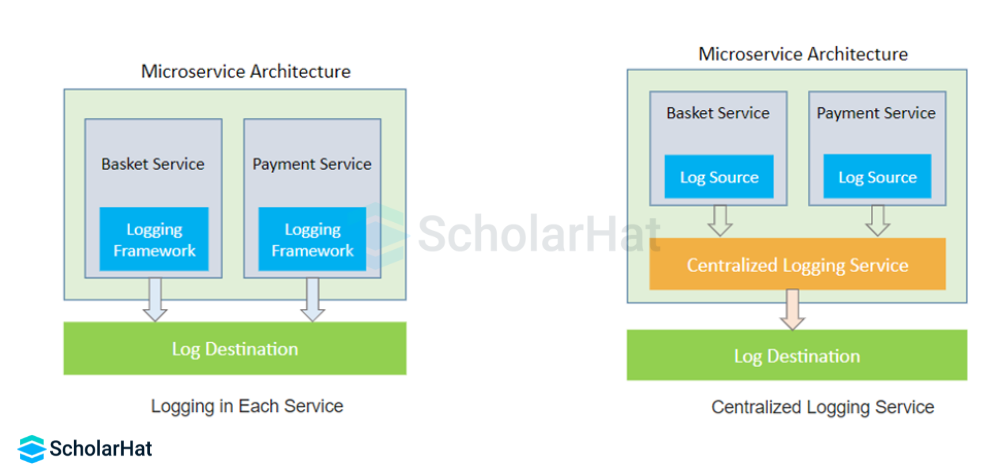
22. Familiarize Yourself with Monitoring and Logging Tools
- OpenTelemetry: Explore OpenTelemetry, an open-source observability framework that provides standardized instrumentation, telemetry collection, and distributed tracing capabilities for monitoring microservices. OpenTelemetry supports multiple programming languages, including .NET, and integrates with various monitoring systems and backend storage solutions.
- Grafana: Learn about Grafana, an open-source analytics and visualization platform commonly used for monitoring and observability. Grafana allows you to create custom dashboards to visualize metrics, logs, and traces collected from microservices, enabling real-time monitoring and trend analysis.
- ELK Stack: Familiarize yourself with the ELK Stack, which consists of Elasticsearch, Logstash, and Kibana. Elasticsearch is a distributed search and analytics engine used for indexing and searching logs. Logstash is a data processing pipeline for ingesting and processing log data. Kibana is a visualization and analytics platform for exploring and visualizing log data stored in Elasticsearch.

23. Implement Monitoring and Logging in .NET Microservices
- Instrumentation: Learn how to instrument .NET microservices to emit metrics, logs, and traces using libraries and frameworks compatible with OpenTelemetry. Instrumentation involves adding code to microservices to capture relevant telemetry data and send it to monitoring systems.
- Log Aggregation: Set up log aggregation pipelines to collect and centralize logs generated by .NET microservices using tools like Logstash or other log shippers. Log aggregation helps consolidate logs from multiple microservices into a centralized repository for easier analysis and troubleshooting.
- Dashboard Creation: Create custom dashboards in Grafana or other visualization platforms to monitor key metrics and visualize logs collected from .NET microservices. Dashboards provide a centralized view of the health and performance of microservices, enabling efficient monitoring and alerting.
24. Understanding Security Best Practices
- OAuth: OAuth (Open Authorization) is an industry-standard protocol for authorization that allows third-party services to access resources on behalf of a resource owner. It provides a secure and delegated access mechanism, often used for API authentication and authorization.
- JWT (JSON Web Tokens): JWT is a compact, URL-safe means of representing claims to be transferred between two parties. It's commonly used for token-based authentication and authorization in web applications and APIs. JWTs are digitally signed, ensuring their integrity and allowing parties to verify the authenticity of the claims they contain.
- Secure Communication: Secure communication between microservices involves ensuring confidentiality, integrity, and authenticity of data exchanged between services. This includes implementing encryption, authentication, and authorization mechanisms to protect against unauthorized access and data breaches.
25. Implementing Secure Communication between Services
- OAuth Integration: Implement OAuth for authentication and authorization between microservices. Each microservice can act as an OAuth client, obtaining access tokens from an OAuth provider (e.g., IdentityServer) to access protected resources in other microservices.
- JWT-Based Authentication: Use JWTs for authentication between microservices. When a client authenticates with one microservice, it receives a JWT containing claims (e.g., user roles or permissions). This JWT can then be used to authenticate subsequent requests to other microservices without needing to re-authenticate.
- Token Validation: Validate JWTs received from clients or other microservices to ensure their integrity and authenticity. Verify the signature of the JWT using the public key of the issuer (e.g., IdentityServer) to confirm that it hasn't been tampered with and was issued by a trusted party.
- Role-Based Access Control (RBAC): Implement RBAC to enforce access control policies based on user roles or permissions encoded in JWT claims. Restrict access to sensitive resources or operations within microservices based on the roles or permissions granted to the requesting user.
26. Continuous Integration (CI)
- Automated Build: Set up automated build pipelines using CI/CD tools like Azure DevOps, Jenkins, or GitHub Actions. Configure build triggers to automatically start a build whenever changes are pushed to the source code repository.
- Compile and Package: Configure the build pipeline to compile the source code of each microservice and package it into a deployable artifact, such as a Docker image or a NuGet package.
- Unit Testing: Integrate unit tests into the build pipeline to ensure that changes to the codebase do not introduce regressions. Run unit tests automatically as part of the build process, and fail the build if any tests fail.
27. Continuous Deployment (CD)
- Automated Deployment: Set up automated deployment pipelines to deploy microservices to staging and production environments. Define deployment stages for each environment and configure deployment triggers to automatically deploy artifacts to the respective environments after a successful build.
- Deployment Strategies: Implement deployment strategies such as blue-green deployments, canary releases, or rolling deployments to minimize downtime and risk during deployments. Choose the deployment strategy that best fits the requirements of your microservices architecture.
- Configuration Management: Manage environment-specific configurations (e.g., connection strings, API keys) separately from the codebase and inject them into microservices at runtime. Use tools like Azure Key Vault or environment variables to securely manage and inject sensitive configuration data.
28. Pipeline Orchestration and Monitoring
- Pipeline Orchestration: Define the sequence of CI/CD tasks and stages in the pipeline to orchestrate the build, testing, and deployment process of microservices. Ensure that dependencies between microservices are handled appropriately to prevent deployment failures.
- Monitoring and Alerts: Implement monitoring and alerting mechanisms to track the health and performance of CI/CD pipelines. Set up alerts to notify stakeholders in case of build failures, deployment errors, or performance degradation, allowing for timely intervention and resolution.
29. Infrastructure as Code (IaC)
- Infrastructure Provisioning: Use infrastructure as code (IaC) tools like Terraform or Azure Resource Manager (ARM) templates to provision and configure infrastructure resources (e.g., virtual machines, Kubernetes clusters) required for hosting microservices. Define infrastructure configurations as code to enable reproducible and consistent environments across different stages of the CI/CD pipeline.
- Immutable Infrastructure: Adopt the principle of immutable infrastructure, where infrastructure components are treated as disposable and are replaced rather than modified. Deploy microservices to immutable infrastructure to ensure consistency and predictability in deployments.
30. Understanding Cloud Platforms
- Microsoft Azure: Familiarize yourself with Microsoft Azure, a cloud computing platform and services offered by Microsoft. Azure provides a wide range of cloud services, including computing, storage, networking, databases, machine learning, and more. It supports various programming languages and frameworks, including .NET, making it suitable for hosting .NET microservices.
- Amazon Web Services (AWS): Learn about Amazon Web Services (AWS), a comprehensive cloud computing platform provided by Amazon. AWS offers a vast array of services, such as computing (e.g., EC2, Lambda), storage (e.g., S3, EBS), databases (e.g., RDS, DynamoDB), networking, machine learning, and more. AWS also supports .NET applications and provides SDKs and tools for .NET developers.
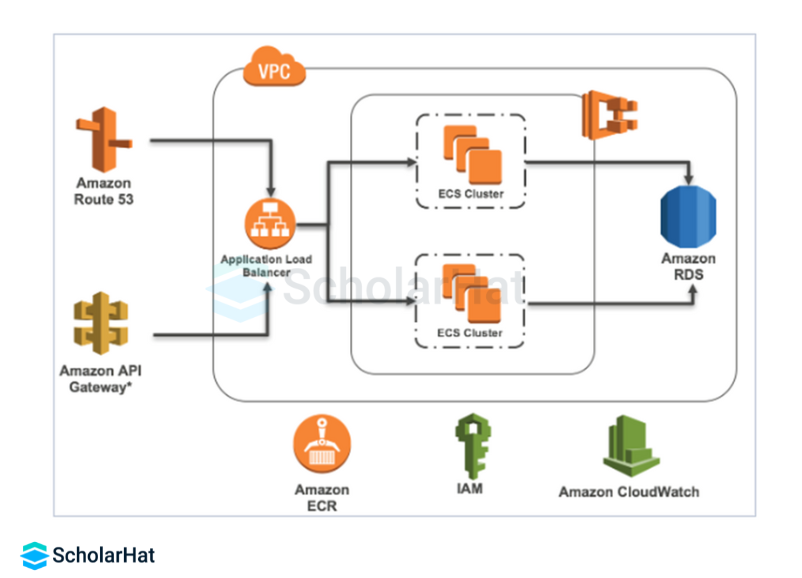
31. Deploying .NET Microservices on Cloud Platforms
- Compute Services: Explore compute services provided by Azure and AWS, such as Azure App Service, Azure Kubernetes Service (AKS), AWS Elastic Beanstalk, AWS Lambda, or EC2. These services allow you to deploy and manage .NET microservices on scalable and reliable infrastructure.
- Containerization: Utilize container services like Azure Container Instances (ACI), Azure Kubernetes Service (AKS), Amazon Elastic Container Service (ECS), or Amazon Elastic Kubernetes Service (EKS) for deploying containerized .NET microservices. Containers provide portability and scalability, allowing you to run microservices consistently across different environments.
- Serverless Computing: Consider serverless computing options such as Azure Functions or AWS Lambda for hosting event-driven .NET microservices. Serverless platforms abstract away infrastructure management, allowing you to focus on writing code without worrying about server provisioning or scaling.
32. Integration with Cloud Services
- Storage Services: Integrate .NET microservices with cloud storage services such as Azure Blob Storage, Azure Table Storage, Azure SQL Database, AWS S3, or AWS RDS for persisting data and managing file storage.
- Messaging and Event Streaming: Utilize messaging and event streaming services like Azure Service Bus, Azure Event Hubs, AWS SQS, or AWS Kinesis for asynchronous communication and event-driven architectures between microservices.
- Security and Identity Services: Leverage cloud-native security and identity services such as Azure Active Directory (Azure AD) or AWS Identity and Access Management (IAM) for managing authentication, authorization, and access control in .NET microservices applications.
Real World Projects
- eShopOnContainers: eShopOnContainers is a Microsoft-developed open-source application showcasing microservices architecture with .NET technologies. It illustrates microservices patterns including containerization, Kubernetes orchestration, and event-driven communication. The application simulates an e-commerce platform with features like product catalog, shopping cart, and order and payment processing.
- Healthcare Patient Management System: .NET microservices can power a healthcare system handling patient care aspects such as appointment scheduling, electronic health records (EHR), billing, and communication. Each microservice can specialize in domains like appointment management, patient information, billing, and notifications for scalability and maintainability.
- Financial Services Platform: Leveraging .NET microservices, a financial platform can offer services like account management, transaction processing, risk analysis, and reporting. Each microservice manages specific financial operations, enabling agility and scalability. For instance, one microservice handles account management while another deals with transaction processing and fraud detection.
- Retail Inventory and Order Management System: .NET microservices are ideal for a retail system managing inventory, order processing, fulfillment, and shipping. Microservices can handle different aspects like inventory tracking, order routing, and payment processing, providing flexibility in scaling and integrating with third-party services.
- Media Streaming Platform: Building a media streaming platform, like a video-on-demand (VOD) or music service, using .NET microservices allows for content management, user authentication, recommendation engines, and content delivery. Each microservice manages specific content domains like video metadata, user preferences, and payment processing for scalability and flexibility in serving a large user base.
Summary
In short, mastering the.NET Microservices Development roadmap entails grasping core ideas, adopting essential technologies such as ASP.NET Core and Docker, and negotiating complexity and governance. Real-world examples like eShopOnContainers demonstrate the power of microservices to build scalable, resilient, and flexible applications across multiple domains.
Take our free skill tests to evaluate your skill!

In less than 5 minutes, with our skill test, you can identify your knowledge gaps and strengths.

